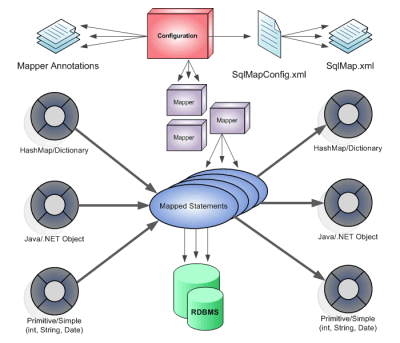MyBatis 3.1.1 API
在线地址:http://tool.oschina.net/apidocs/apidoc?api=mybatis-3.1.1
原文:http://blog.csdn.net/caodegao/article/details/6735049
MyBatis现在还挺少人用的,刚玩的时候在网站查资料都没有很多贴研究它.走了很多弯路;
在此做了一个小例子,跟大家分享一下;
如果能对一些刚玩MyBatis的朋友一些帮助就再好不过了.
首先给大家配置MyBatis的前奏,毕竟什么框架都是配置出来的,大家得下载MyBatis的文档,上面有很详细的配置前奏.
我就不给大家贴出来了.我是用Spring和Struts2集成的.别怪我太自私啊!下次慢慢在贴出集成的例子,
先给大家sql的配置吧
我有一个总文件mybatis-config.xml,在总文件加载子文件,这样至少分工还算明细些.
<?xml version="1.0" encoding="UTF-8" ?> <!DOCTYPE configuration PUBLIC "-//mybatis.org//DTD Config 3.0//EN" "http://mybatis.org/dtd/mybatis-3-config.dtd"> <configuration> <typeAliases> <typeAlias alias="Account" type="com.cookiejoo.beans.Account" /> <typeAlias alias="Weibo" type="com.cookiejoo.beans.Weibo" /> </typeAliases> <mappers> <mapper resource="mybatisConfig/account-mapper.xml" /> <mapper resource="mybatisConfig/weibo-mapper.xml" /> </mappers> </configuration>
重点在这个weibo-mapper.xml里面,这个也一样自己写他的sql映射account-mapper.xml
由于就演示一个表weibo关联表account,关联都在weibo-mapper.xml里面写.account-mapper.xml就不给大家了,没什么大碍的.
配置文件的详细我都写了,大家靠自己的悟性吧
<?xml version="1.0" encoding="UTF-8" ?> <!DOCTYPE mapper PUBLIC "-//mybatis.org//DTD Mapper 3.0//EN" "http://mybatis.org/dtd/mybatis-3-mapper.dtd"> <!-- 命名空间都以pojo类的包命名,很长,但是也好区分,文档上说这是MyBatis现在的规定了 --> <mapper namespace="com.cookiejoo.beans.Weibo"> <!-- 定义一张表,并且来个关联表 --> <resultMap type="Weibo" id="weiboJoinAccountResultMap"> <id property="wId" column="w_id" /> <result property="wContext" column="w_context" /> <result property="wCreateTime" column="w_create_time" /> <!-- 关联account表 --> <association property="account" column="w_acc_id" javaType="Account" resultMap="joinAccountResult" /> </resultMap> <!-- 关联表需要的列 --> <resultMap type="Account" id="joinAccountResult"> <id property="aId" column="a_id" /> <result property="aUsername" column="a_username" /> <result property="aHeadImage" column="a_head_image" /> </resultMap> <!-- 定义没有关联的单表查询返回结果 --> <resultMap type="Weibo" id="weiboResultMap"> <id property="wId" column="w_id" /> <result property="wContext" column="w_context" /> <result property="wCreateTime" column="w_create_time" /> <!-- 关联account表 --> <association property="account" column="w_acc_id" javaType="Account" resultMap="joinAccountResult" /> </resultMap> <!-- 根据创建时间查询 --> <select id="findWeiboJoinAccount" resultMap="weiboJoinAccountResultMap" parameterType="Weibo"> select w.w_id,w.w_context,w.w_create_time, a.a_id as w_acc_id,a.a_username,a.a_head_image from weibo w left outer join account a on w.w_acc_id = a.a_id where w.w_create_time > #{wCreateTime} order by w.w_create_time desc </select> <!-- resultMap 返回 上面的结果 --> <select id="findAllWeibo" resultMap="weiboResultMap"> select w.w_id,w.w_context,w.w_create_time, a.a_id from weibo w left join account a on w.w_acc_id = a.a_id </select> <!-- 查询一条记录 --> <!-- 注意:此处的关联,看pojo类是怎么写的,如果查询出现什么错误,得看这里了 --> <select id="findAllWeiboById" parameterType="int" resultMap="weiboResultMap"> select w.w_id,w.w_context,w.w_create_time, w.w_acc_id from weibo w where w.w_id = #{wId} </select> <!-- 首先,如果你的数据库支持自动生成主键的字段(比如MySQL和SQL Server), 那么你可以设置useGeneratedKeys=”true”, 而且设置keyProperty到你已经做好的目标属性上。 例如,如果上面的Author表已经对id使用了自动生成的列类型,那么语句可以修改为 --> <insert id="addWeibo" parameterType="Weibo" useGeneratedKeys="true" keyProperty="wId"> insert into weibo(w_acc_id,w_context,w_create_time) values(#{account.aId},#{wContext},#{wCreateTime}) </insert> <!-- 修改 --> <update id="updateWeibo" parameterType="Weibo"> update weibo set w_acc_id = #{account.aId},w_context = #{wContext},w_create_time = #{wCreateTime} where w_id = #{wId} </update> <!-- 删除 --> <delete id="deleteWeibo" parameterType="int"> delete from weibo where w_id = #{wId} </delete> </mapper>
pojo类:这里你要注意了, 怎么给数据做搜集,
package com.cookiejoo.beans; import java.util.Date; public class Weibo { private Integer wId; private Account account; private String wContext; private Date wCreateTime; public Weibo() { } public Integer getWId() { return wId; } public void setWId(Integer wId) { this.wId = wId; } public Account getAccount() { return account; } public void setAccount(Account account) { this.account = account; } public String getWContext() { return wContext; } public void setWContext(String context) { wContext = context; } public Date getWCreateTime() { return wCreateTime; } public void setWCreateTime(Date createTime) { wCreateTime = createTime; } }
两张表结构很简单
id都是自动增长的;
Table weibo
===========
w_id, w_acc_id, w_context, w_create_time
-----------
w_id int(11) PK
w_acc_id int(11)
w_context varchar(2000)
w_create_time datetime
Table account
=============
a_id, a_username, a_password, a_sex, a_phone, a_brithday, a_create_time, a_head_image
-------------
a_id int(11) PK
a_username varchar(45)
a_password varchar(45)
a_sex int(2)
a_phone varchar(15)
a_brithday datetime
a_create_time datetime
a_head_image varchar(45)
这个是java调用的例子,一个接口一个实现类,我用了Spring集成了,所以和单独的MyBatis例子有点出入,大家对着MyBatis文档做时就是获取getSqlSession这个不一样而已.
package com.cookiejoo.iservice.impl; import java.util.Date; import java.util.List; import org.mybatis.spring.support.SqlSessionDaoSupport; import com.cookiejoo.beans.Weibo; import com.cookiejoo.iservice.IWeiboService; public class WeiboServiceImpl extends SqlSessionDaoSupport implements IWeiboService { @SuppressWarnings("unchecked") public List<Weibo> findWeiboJoinAccount(Weibo w) { return getSqlSession().selectList( "com.cookiejoo.beans.Weibo.findWeiboJoinAccount", w); } @SuppressWarnings("unchecked") public List<Weibo> findAllWeibo() { return getSqlSession().selectList( "com.cookiejoo.beans.Weibo.findAllWeibo"); } public void addWeibo(Weibo w) { w.setWCreateTime(new Date()); getSqlSession().insert("com.cookiejoo.beans.Weibo.addWeibo", w); } public void updateWeibo(Weibo w) { getSqlSession().update("com.cookiejoo.beans.Weibo.updateWeibo", w); } public void deleteWeibo(Weibo w) { getSqlSession().delete("com.cookiejoo.beans.Weibo.deleteWeibo", w); } public Weibo findAllWeiboById(Integer wId) { return (Weibo) getSqlSession().selectOne( "com.cookiejoo.beans.Weibo.findAllWeiboById", wId); } }
接着页面展示,我用jsp写的,用struts2做跳转... myJsp.jsp
<%@ page language="java" pageEncoding="UTF-8"%> <%@ taglib prefix="c" uri="http://java.sun.com/jsp/jstl/core"%> <%@ taglib prefix="s" uri="/struts-tags"%> <!DOCTYPE html PUBLIC "-//W3C//DTD XHTML 1.0 Strict//EN" "http://www.w3.org/TR/xhtml1/DTD/xhtml1-strict.dtd"> <html xmlns="http://www.w3.org/1999/xhtml"> <head> <meta http-equiv="content-type" content="text/html; charset=utf-8" /> <title>Condition by Free CSS Templates</title> <meta name="keywords" content="" /> <meta name="description" content="" /> <style type='text/css'> #mytable { padding: 0; margin: 0; } th { color: #4f6b72; border-left: 1px solid #C1DAD7; border-right: 1px solid #C1DAD7; border-bottom: 1px solid #C1DAD7; border-top: 1px solid #C1DAD7; letter-spacing: 2px; text-transform: uppercase; text-align: left; padding: 6px 6px 6px 12px; background: #CAE8EA no-repeat; } td { border-left: 1px solid #C1DAD7; border-right: 1px solid #C1DAD7; border-bottom: 1px solid #C1DAD7; background: #fff; padding: 6px 6px 6px 12px; color: #4f6b72; } </style> </head> <body> ------------------------------------------------------------------------------------------- <form action="findAllWeibo.action"><input value="findAllWeibo" type="submit"/> <input name="weibo.wCreateTime" type="text" value="2011-01-01"/> </form> ------------------------------------------------------------------------------------------- <form action="addWeibo.action"> <input name="weibo.wContext" type="text" value="2011-01-01"/><br> <input name="weibo.account.aId" type="text" value="1"/><br> <input name="weibo.wCreateTime" type="text" value="2011-01-01"/> <input value="addWeibo" type="submit"/> </form> ------------------------------------------------------------------------------------------- <form action="updateWeibo.action"> <input name="weibo.wContext" type="text" value="2011-02-01"/><br> <input name="weibo.account.aId" type="text" value="2"/><br> <input name="weibo.wCreateTime" type="text" value="2011-02-01"/> <input name="weibo.wId" type="text" value="54"/> <input value="updateWeibo" type="submit"/> </form> <a href="findWeiboByBean.action">findWeiboByBean</a> <h3></h3> <br> <table id='mytable' cellspacing='0' width='100%'> <tr> <th>id</th><th>context</th><th>createTime</th><th>aid</th><th>operator</th></tr> <c:forEach items="${weibos}" var="weibo"> <tr><td>${weibo.WId }</td><td>${weibo.WContext }</td><td>${weibo.WCreateTime }</td><td>${weibo.account.AId }</td><td><a href="deleteWeibo.action?weibo.wId=${weibo.WId }">delete</a></td></tr> </c:forEach> </table> </body> </html>

原文:http://blog.csdn.net/bluesky5219/article/details/7066174
本文主要介绍Spring与Mybatis三种常用整合方法,需要的整合架包是mybatis-spring.jar,可通过链接
http://code.google.com/p/mybatis/下载到。
1、采用数据映射器(MapperFactoryBean)的方式,不用写mybatis映射文件,采用注解方式提供相应的sql语句和输入参数。
(1)Spring配置文件:
<!-- 引入jdbc配置文件 -->
<context:property-placeholder location="jdbc.properties"/>
<!--创建jdbc数据源 -->
<bean id="dataSource" class="org.apache.commons.dbcp.BasicDataSource" destroy-method="close">
<property name="driverClassName" value="${driver}"/>
<property name="url" value="${url}"/>
<property name="username" value="${username}"/>
<property name="password" value="${password}"/>
<property name="initialSize" value="${initialSize}"/>
<property name="maxActive" value="${maxActive}"/>
<property name="maxIdle" value="${maxIdle}"/>
<property name="minIdle" value="${minIdle}"/>
</bean>
<!-- 创建SqlSessionFactory,同时指定数据源-->
<bean id="sqlSessionFactory" class="org.mybatis.spring.SqlSessionFactoryBean">
<property name="dataSource" ref="dataSource" />
</bean>
<!--创建数据映射器,数据映射器必须为接口-->
<bean id="userMapper" class="org.mybatis.spring.mapper.MapperFactoryBean">
<property name="mapperInterface" value="com.xxt.ibatis.dbcp.dao.UserMapper" />
<property name="sqlSessionFactory" ref="sqlSessionFactory" />
</bean>
<bean id="userDaoImpl2" class="com.xxt.ibatis.dbcp.dao.impl.UserDaoImpl2">
<property name="userMapper" ref="userMapper"/>
</bean>
原文:http://www.oschina.net/p/mybatis
5月23日 西安 OSC 源创会开始报名啦,存储、虚拟机、Docker 等干货分享
MyBatis 的前身就是 iBatis 。是一个数据持久层(ORM)框架。

iBATIS一词来源于“internet”和“abatis”的组合,是一个基于Java的持久层框架。iBATIS提供的持久层框架包括SQL Maps和Data Access Objects(DAO),同时还提供一个利用这个框架开发的 JPetStore实例。
在线Javadoc:http://tool.oschina.net/apidocs/apidoc?api=mybatis-3.1.1
- MyBatis 3.2.8 发布,Java 数据库持久层框架7个月前18评/5035阅
- MyBatis 3.2.1 发布,Java 数据库持久层框架2年前8评/3105阅
- MyBatis 3.2.0 发布,Java 数据库持久层框架2年前47评/5175阅
- MyBatis 3.0.6 发布4年前4评/2510阅
- 开源中国5-4期开源软件推荐 MyBatis5年前1评/2029阅
- 授权协议: Apache
- 开发语言: Java
- 操作系统: 跨平台
- 收录时间: 鉴客 -> 2010年05月22日
